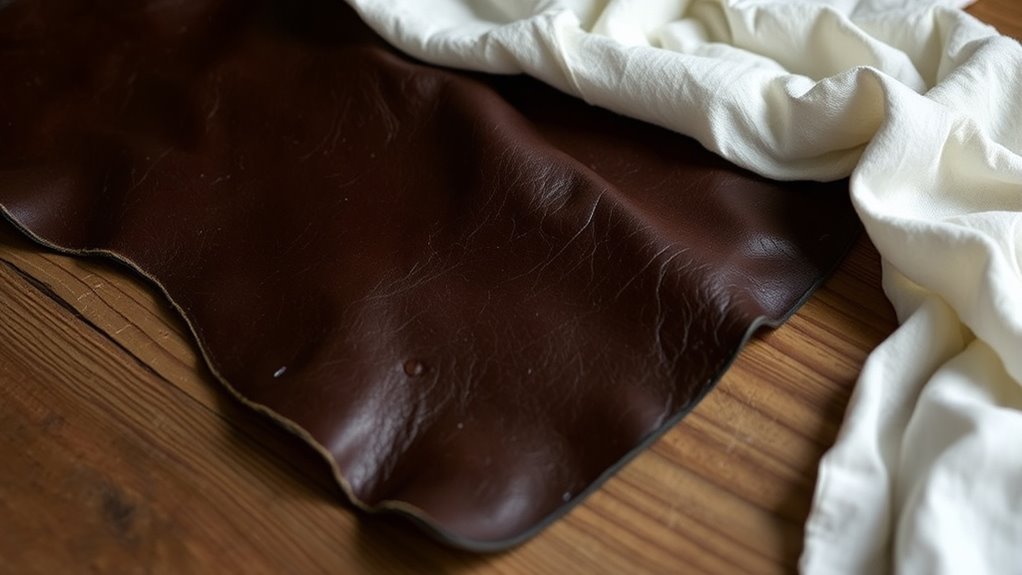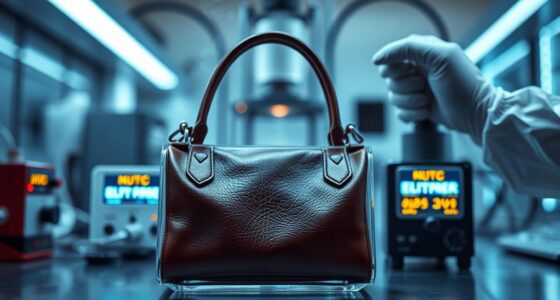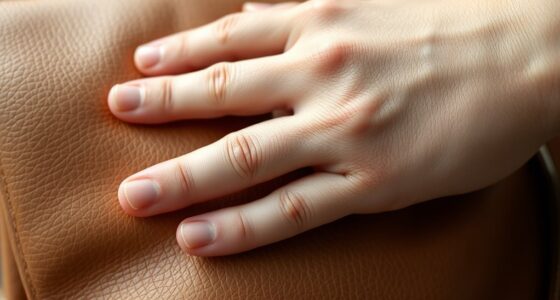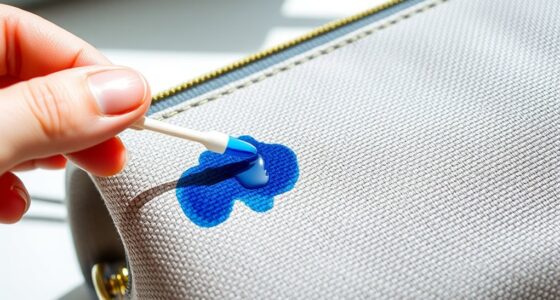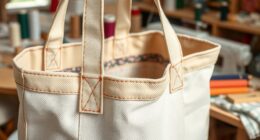When air-drying wet leather, gently blot excess moisture with a soft cloth and keep it in a well-ventilated area away from direct sunlight and heat. Avoid rushing the process or using heat sources, which can cause cracking, and never leave leather damp for too long to prevent mold. Support the leather properly and control humidity. To learn more about keeping your leather in top shape, continue exploring these essential tips.
Key Takeaways
- Gently blot excess moisture with a soft cloth, avoiding rubbing or applying direct heat.
- Air dry in a well-ventilated area away from sunlight and heat sources to prevent cracking.
- Use humidity control and support the leather properly to maintain its shape during drying.
- Do not rush the process or leave damp leather untreated, which can cause mold and damage.
- After drying, condition the leather to restore flexibility and prevent stiffness.
Essential Steps to Safely Air-Dry Wet Leather
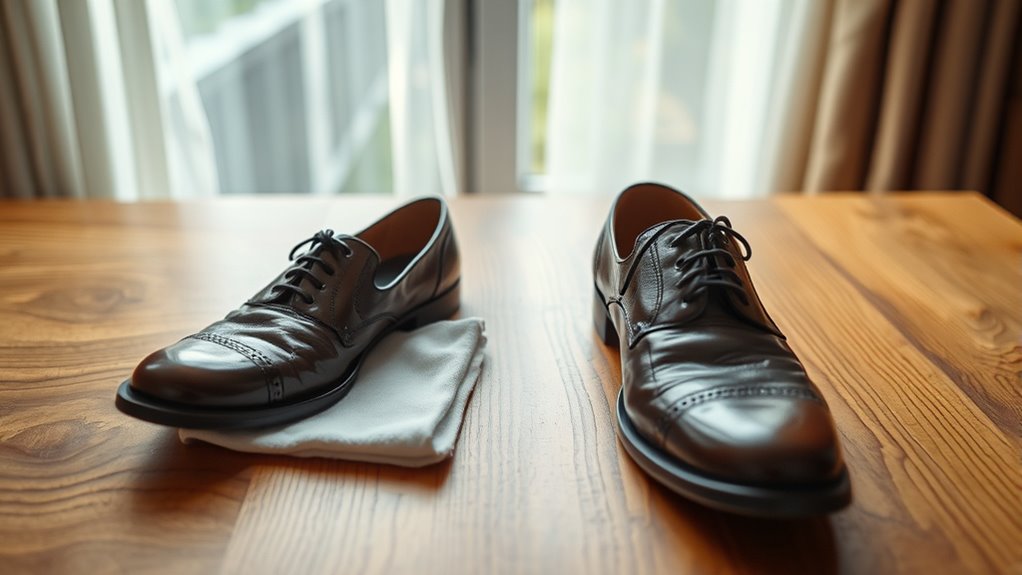
To safely air-dry wet leather, you need to follow a few essential steps. First, gently blot excess moisture with a soft cloth—avoid rubbing, which can damage the material. Next, place the leather in a well-ventilated area away from direct sunlight or heat sources, as these can cause cracking. Maintain humidity control by using a dehumidifier or air conditioner if the environment is too humid, helping prevent mold growth. Incorporate leather conditioning once the surface is dry; this helps restore flexibility and prevents stiffness. Keep the leather flat or supported properly to maintain its shape during drying. Using a dedicated air purifier can help improve indoor air quality and reduce airborne pollutants that might affect the drying process. Additionally, choosing appropriate storage conditions can further safeguard your leather from environmental damage. Proper air circulation is essential for even drying and to avoid damp spots that could lead to deterioration. Ensuring adequate air quality can also prevent the buildup of mold spores and other pollutants that may harm the leather. Patience is key—rushing the process can compromise the leather’s integrity. Following these steps ensures your leather dries safely while preserving its quality and longevity.
Common Mistakes to Avoid When Drying Leather
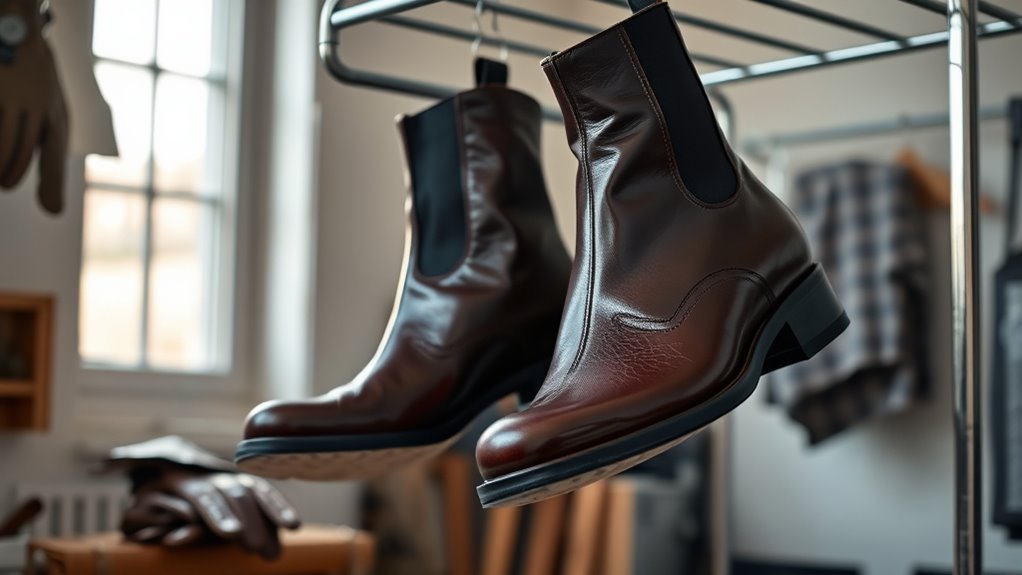
While following proper air-drying techniques is important, avoiding common mistakes can make or break the process. One major error is rushing the drying, which can cause leather cracking. Never use direct heat or sunlight, as this accelerates drying unevenly and damages the material. Additionally, neglecting mold prevention can lead to unpleasant odors and deterioration; always ensure good airflow and keep leather in a dry environment.
Avoid rushing or exposing leather to direct heat to prevent cracking and damage.
Be mindful of these pitfalls:
- Avoid drying leather too quickly or in direct heat, preventing cracking.
- Never leave leather damp for long periods, which encourages mold growth.
- Don’t ignore proper storage; improper conditions can cause mold and damage the leather’s integrity.
Frequently Asked Questions
How Long Does It Typically Take for Leather to Fully Dry Naturally?
When you ask about how long it takes for leather to fully dry naturally, it really depends on the leather’s moisture level and environmental conditions. Typically, the drying time can range from 24 to 48 hours, but thicker or wetter leather may take longer. You should check regularly to guarantee it’s drying evenly, and avoid rushing the process to prevent damage. Patience is key for proper drying.
Can Air-Drying Cause Leather to Crack or Stiffen?
Air-drying wet leather can cause it to crack or stiffen if you’re not careful. As it dries naturally, the leather loses moisture unevenly, leading to cracks and stiffening over time. To prevent this, you should avoid direct sunlight and high heat, which accelerate drying and damage. Instead, let it dry slowly in a well-ventilated area, and consider conditioning afterward to maintain its flexibility and prevent leather cracking or stiffening.
Should I Apply Any Conditioner Before or After Air-Drying?
Ever wonder if you should condition leather before or after air-drying? It’s best to follow a proper drying schedule and then apply leather conditioning once the leather is completely dry. Conditioning too early can trap moisture, leading to damage. So, wait until your leather is dry, then use a quality conditioner to restore suppleness and prevent cracking. This approach keeps your leather in top shape and prolongs its lifespan.
Is It Safe to Use Fans or Heaters to Speed up Drying?
Using fans can help with fan acceleration, speeding up the drying process safely. However, you should avoid heaters because heat hazards can damage leather, causing it to crack or warp. Keep fans at a safe distance and avoid direct heat sources. This way, you dry your leather evenly without risking damage, ensuring it stays supple and in good condition.
How Can I Tell if the Leather Is Completely Dry?
Think of your leather like a sponge—once it’s fully dry, it shouldn’t feel damp or cool to the touch. To check if it’s dry, look for consistent dryness and no residual moisture on the surface. Feel for firmness and avoid any sticky or tacky spots. Drying indicators include no more leather moisture seeping out and a natural, supple feel. When these signs appear, your leather’s ready and fully dry.
Conclusion
Remember, air-drying leather carefully isn’t just about avoiding damage—it’s about trusting the process. Some believe that exposing wet leather to direct sunlight speeds up drying, but it can actually cause cracking and fading. Instead, patience and proper techniques ensure your leather stays supple and beautiful. So, don’t rush or cut corners; rely on that gentle air-drying, combined with the right steps, keeps your leather in top shape for years to come.
